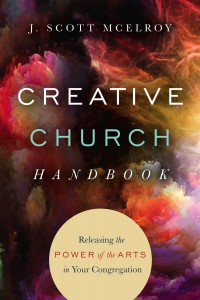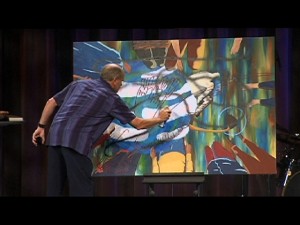 Welcome to the online extras and resources for Chapter 9: Applications for the Arts and Creativity in Sermons of The Creative Church Handbook. What you’ll find here is material that is helpful and important, but couldn’t be included in the book because of space constraints. Some thoughts include a reference to the specific page they would have appeared on.
Welcome to the online extras and resources for Chapter 9: Applications for the Arts and Creativity in Sermons of The Creative Church Handbook. What you’ll find here is material that is helpful and important, but couldn’t be included in the book because of space constraints. Some thoughts include a reference to the specific page they would have appeared on.
For information and discussion on similar topics see The New Renaissance Arts Movement site at TheNewR.org. For questions, comments, or use permissions you may contact the author directly at Scott (at) TheNewR.org.
Visit our CreativeChurchArtsIdeas.org website for more ideas for creativity and arts ministry in the local church!
The page is under construction. Please check back for updates!
Chapter 9: Applications for the Arts and Creativity in Sermons
Words that spark the imagination:
Jesus was constantly activating the listener’s imagination with his parables to get a truth across. As I said, the use of words is obviously the most common way of capturing a listener’s attention. Much has been written about this, but I couldn’t resist quoting another thought from Tim Keller on the subject:

destroys a painting by spray painting over it. Photo used
with permission of Blackhawk Church.
“(Jonathan) Edwards said that unless you use imagination, unless you take a truth and image it—which of course it art—you don’t know what it means. If you cannot visualize it, you don’t have a sense of it on your heart. We see this in one of Edwards’s sermons, called “Sinners in the hands of an angry God”. Edwards, at one point in the sermon, looks at the congregation and says, “Your righteousness cannot keep you out of hell”. That is a truth. You may not believe it, but there is the principal. While that is the content of what he is saying, he says it in a way that better makes the point. He says, “ Your wickedness makes you, as it were, heavy as lead, and to tend downwards with great weight and pressure towards hell; and if God should let you go, you would immediately sink and swiftly descend and plunge into the bottomless gulf, and your healthy constitution, and your own care and prudence, and best contrivance, and all your righteousness, would have no more influence to uphold you and keep you out of hell, than a spiders web would have to stop a falling rock. “
Now as soon as he said that, what has he done? He has used imagination, moving from truth into the area of visualization. As a result you have a clearer sense of what he means. Even if you don’t agree with the concept, you begin to recognize what it going on. You may not have understood what he meant until he crossed over into another mode—until he put it in the form of a sense experience and showed you what it looked and felt like. This sensual expression of the truth allows you to hear the truth, to see the truth, to taste it, touch it and smell it.
(This a selection from an essay by Timothy J. Keller in the book It Was Good: Making Art to the Glory of God, Square Halo

it with a knife. Photo used with permission of Blackhawk Church.
Books, Lancaster, PA. (April 1, 2007) pg 183)
On using movie clips to illustrate a sermon:
There are some dangers to this. You have to be careful not to use these elements for shock value. They can elicit strong emotions, disturb people, or distract them and make them think about the rest of the movie instead of listening to the message. So if you are using a strong movie clip, make sure your follow up and message are equally strong. And, of course, don’t just plug something in because it seems to fit. Again, ask the Holy Spirit for his guidance in what clips to use or whether to include these things in a particular message at all.
More creativity exercises:
• Restrict Yourself
The research shows an insidious problem that many people have is that they will often take the path of “least mental resistance,” building on ideas they already have or trying to use every resource at hand. The thing is, the research also suggests that placing self-imposed limitations can boost creativity because it forces even creative people to work outside of their comfort zones (which they still have, even if they are a bit “weirder” than most).
One of the most famous examples is when Dr. Seuss produced Green Eggs & Ham after a bet where he was challenged by his editor to produce an entire book in under 50 different words. I’m no Dr. Seuss, but I’ve found (and I’m sure other writers can relate) that when I’m suddenly restricted to writing something in 500 words when I had planned to write it in 800 words, it can lead to some pretty creative workarounds.

and constructed by the artists at
Mosaic. It’s one of five statues that
imaginatively illustrated the core
values of the church. Water designed by
Patrick Diaz. Photo: Josh Anderson.
Try limiting your work in some way and you may see the benefits of your brain coming up with creative solutions to finish a project around the parameters you’ve set.
( This is taken from an article from Gregory Ciotti.
http://lifehacker.com/5990617/nine-of-the-best-ways-to-boost-creative-thinking )
• Take a break.
Those who study multi-tasking report that you can’t work on two projects simultaneously, but the dynamic is different when you have more than one creative project to complete. In that situation, more projects get completed on time when you allow yourself to switch between them if solutions don’t come immediately. This corroborates surveys showing that professors who set papers aside to incubate ultimately publish more papers. Similarly, preeminent mathematicians usually work on more than one proof at a time. (This is taken from: http://www.newsweek.com/forget-brainstorming-74223)
Additional resources are the books:
Preaching in an Age of Distraction by J. Ellsworth Kalas (especially pages 103-108)
Rewiring Your Preaching: How the Brain Processes Sermons By Richard H. Cox

